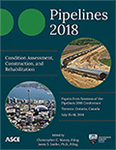Pipelines 2018
Qualitative Investigation of Microbially Induced Corrosion of Concrete in Sanitary Sewer Pipe and Manholes
Publication: Pipelines 2018: Condition Assessment, Construction, and Rehabilitation
ABSTRACT
Microbially induced corrosion (MIC) of concrete is a major cause of deterioration in sanitary sewer systems and requires considerable amount of rehabilitation investment every year. MIC is caused by the production of hydrogen sulfide by sulfur oxidizing microorganisms present inside the sanitary sewers. The objective of this paper is to investigate solutions for reduction and/or elimination of MIC in the concrete sanitary sewers. This study reviews the cement chemistry, basic science behind concrete deterioration, and MIC production that takes place due to various biological processes which lead to the production of dilute sulfuric acid. Historical attempts to fortify concrete along with methods to reduce odors and corrosion by treatment of raw sewage are discussed. Experimental testing as per ASTM D4783 standard shows resistance of concrete samples to microbial attack with the use of antimicrobial additives.
Get full access to this article
View all available purchase options and get full access to this chapter.
REFERENCES
ASTM D4783–01 (2013). “Standard Test Methods for Resistance of Adhesive Preparations in Container to Attack by Bacteria, Yeast, and Fungi,” ASTM International, West Conshohocken, PA, 2013.
Bell, L. W., Shook, W. E., and Norris, T. (1999). “Mitigating the Corrosion of Concrete Pipe and Manholes,” Concrete Pipe for the New Millennium, ASTM STP1368, J. I. Enyart and I. I. Kaspar, Eds., American Society for Testing and Materials, West Conshohocken, PA, 1999.
Campbell, L. L., Frank, H. A. & Hall, E. R. (1957). “Studies on Thermophilic Sulfate Reducing Bacteria and Identification of Sporovibrio-Desulfuricans as Clostridium Nigrificans.” Journal of Bacteriology, 73, 516–521.
Cheng, L. (2014). “Microbial Biofilm Development on and Degradation of Concrete Surfaces,” A Ph.D. Dissertation, Purdue University, West Lafayette, IN.
EPA, U. S. (2010). Design Manual. Odor and Corrosion Control in Sanitary Sewerage Systems and Treatment Plant. Center for Environmental Research Information, U.S. Environmental Protection Agency.
Franke, L., and Sisomphon, K. (2004). “A New Chemical Method for Analyzing Free Calcium Hydroxide Content in Cementing Material.” Cement and concrete Research, 34(7), 1161–1165.
House, M. W., and Weiss, W.J. (2014). “Review of Microbially Induced Corrosion and Comments on Needs Related to Testing Procedures.” 4th International Conference on the Durability of Concrete Structures, 24–26 July 2014, Purdue University, IN.
Islander, R. L., Devinny, J. S., Mansfeld, F., Postyn, A. & Hong, S. (1991). Microbial Ecology of Crown Corrosion in Sewers. Journal of Environmental Engineering-ASCE, 117, 751–770.
Jensen, H. S., Nielsen, A. H., Hvitved-Jacobsen, T. & Vollertsen, J. (2009). “Modeling of Hydrogen Sulfide Oxidation in Concrete Corrosion Products from Sewer Pipes.”Water Environment Research, 81, 365–373.
Kaushal, V., Najafi, M. and Young, V. (2017). “Microbiologically Induced Concrete Corrosion in Sanitary Sewer Systems.” Trenchless Technology and Pipe Conference, 20 June 2017, University of Texas at Arlington, TX.
Nakatsuk, W. & Akagi, J. M. (1969). “Thiosulfate Reductase Isolated from Desulfotomaculum Nigrificans.”Journal of Bacteriology, 98, 429–433.
Parker, C. D. (1951). “Mechanics of Corrosion of Concrete Sewers by Hydrogen Sulfide.” Sewage and Industrial Wastes, 23, 1477–1485.
Santo Domingo, J. W., Revetta, R. P., Iker, B., Gomez-Alvarez, V., Garcia, J., Sullivan, J., & Weast, J. (2011). “Molecular Survey of Concrete Sewer Biofilm Microbial Communities.” Biofouling, 27, 993–1001.
Taylor, H. F. (1997). Cement Chemistry, 2nd Ed., T. Telford, London 1997.
Yamanaka, T., Aso, I., Togashi, S., Tanigawa, M., Shoji, K., Watanabe, T., Watanabe, N., Maki, K. & Suzuki, H. (2002). “Corrosion by Bacteria of Concrete in Sewerage Systems and Inhibitory Effects of Formateson their Growth.” Water Research, 36, 2636–2642.
Zhang, L., De Schryver, P., De GussemE, B., De Muynck, W., Boon, N. and Verstraete, W. (2008). Chemical and Biological Technologies for Hydrogen Sulfide Emission Control in Sewer Systems: A Review. Water Research, 42, 1–12.
Information & Authors
Information
Published In
Pipelines 2018: Condition Assessment, Construction, and Rehabilitation
Pages: 768 - 775
Editors: Christopher C. Macey, AECOM and Jason S. Lueke, Ph.D., Associated Engineering
ISBN (Online): 978-0-7844-8165-3
Copyright
© 2018 American Society of Civil Engineers.
History
Published online: Jul 11, 2018
Published in print: Jul 12, 2018
Authors
Metrics & Citations
Metrics
Citations
Download citation
If you have the appropriate software installed, you can download article citation data to the citation manager of your choice. Simply select your manager software from the list below and click Download.
